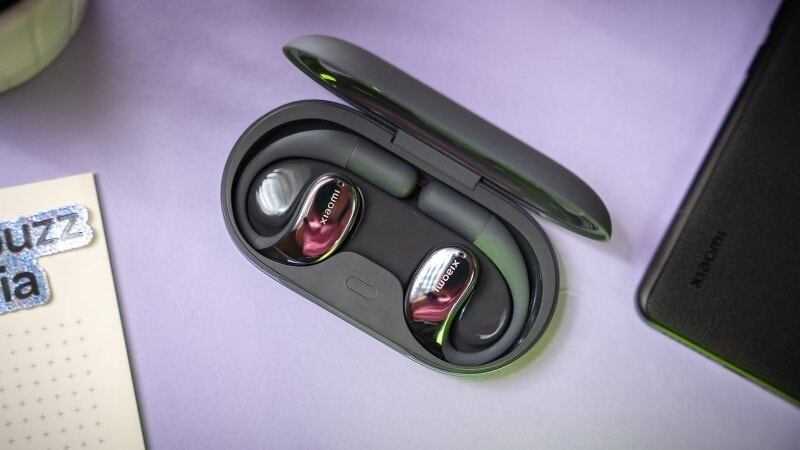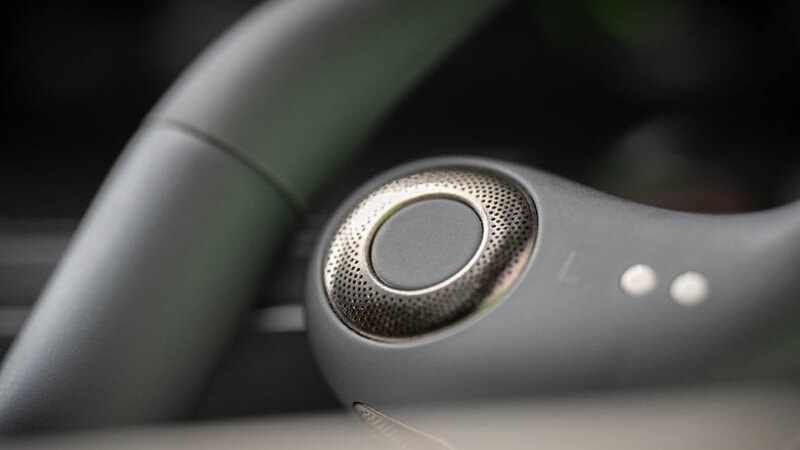Xiaomi OpenWear Stereo and AirPods 4: technical differences
Analyze the open-wear design of Xiaomi OpenWear Stereo and the non-sealed style of AirPods 4, delve into sound transmission, signal processing, ANC, battery life, application and reference price.
The article analyzes two different technical approaches in true wireless headphones: Xiaomi OpenWear Stereo with an open-fit design, with speakers placed a few millimeters away from the ear canal; and Apple AirPods 4 with a design that does not block the ear canal. From the sound transmission principle to signal processing, noise cancellation, connectivity and battery life, these differences directly determine the experience and actual usage scenarios.
Airborne sound transmission and open design: the foundations that make the difference
AirPods 4 eliminates the silicone ear cushions, aiming for comfort and ventilation for users who do not like the feeling of being sealed. Each side weighs 4.3g, does not block the ear canal so it creates less pressure, comes with water and dust resistance (IP54), glossy plastic shell and charging case with magnets to hold the lid firmly. The level of comfort still depends on the shape of each person's ear, but this is one of the most popular comfortable wearing models.

Xiaomi OpenWear Stereo uses an ear hook design, with the speaker placed a few millimeters away from the ear canal, reducing pressure almost completely and holding it firmly when moving around like walking or running. Each side weighs 9.6g, and the nickel-titanium alloy ear hook can withstand 5,000 bends. The product is water and dust resistant (no level specified), and the charging box uses a strong magnet; the chrome-plated surface is modern but prone to fingerprints.

In principle, OpenWear Stereo transmits sound through the air with a small distance to the ear canal, so the bass has difficulty maintaining energy, in exchange for a clear midrange and the ability to hear the natural environment. AirPods 4 are not sealed, so they also prioritize ventilation, but still allow for bass reinforcement thanks to large drivers and signal processing.
Sound and signal processing: drivers, frequency range, space
AirPods 4 use 11mm drivers, a 20Hz – 20kHz frequency range, an integrated H2 chip, and an adaptive audio equalizer that works continuously. Bass is deep and clear at a wide range of volumes even without pads, but vocals tend to be thin and a bit blurry. Spatial audio is available when used with Apple devices, and can be fixed or automatically adjusted according to head movement.

Xiaomi OpenWear Stereo uses 10mm drivers, 20Hz – 40kHz frequency range, slightly bass-heavy but not annoying; vocals and instruments are bright and clear. In addition to the A2DP standard, the headset supports the LHDC codec for high-quality music listening. Because the sound is transmitted through the air, the bass range is almost absent, in return for clear mid-range. The headset also has technology to reduce sound leakage into the environment, making it difficult for people around to hear music from the headset.

Connectivity, software and controls
AirPods 4 connect to iOS and Android. On Android, there is no automatic device switching, and the sound quality is worse than on iOS. On iOS, there is no separate app; users can fine-tune spatial audio, touch controls, sensor and microphone sensitivity, left/right balance, EQ with presets, and a low-signal boost feature.
The OpenWear Stereo is cross-platform compatible and controlled via the Xiaomi Earbuds app (available on the App Store). The app allows you to switch sound profiles (emphasize treble or vocals), customize touch gestures, control the camera in the Xiaomi ecosystem, and connect two earbuds to one phone at the same time. The app does not display battery level and does not have an EQ.
Regarding control: AirPods 4 has a fast response sensor, built-in microphone and accelerometer to interact with Siri. Default operations include one touch to play/pause or receive calls; two touches to end calls, skip tracks; three touches to go back tracks; hold to call Siri; nod to confirm, shake to decline or reject calls. OpenWear Stereo uses a chrome-plated touch surface: two touches to play/pause or end calls; three touches to skip tracks; hold to call virtual assistant; operations can be customized in the application.
Noise cancellation and calls
The standard AirPods 4 do not support active noise cancellation (ANC). Users hear their surroundings clearly, suitable for those who do not want to isolate and are more inclined towards content like podcasts.
OpenWear Stereo combines an open design with partially active ANC, mainly reducing wind noise when cycling and reducing industrial fan noise by about 10-15%, while still hearing environmental sounds. For calls, AirPods 4 uses dual beamforming microphones, the voice is clear but has a reverberating feeling; suitable for quiet environments. OpenWear Stereo has two microphones with AI noise reduction, processing environmental noise better than AirPods 4.

Battery, charging and durability
AirPods 4 offer up to 5 hours of battery life without the charging case; 30 hours total with the case. A full charge of the case takes 50–60 minutes via USB-C. OpenWear Stereo offers 7.5 hours per charge and 38.5 hours total with the case; a 10-minute quick charge adds a few hours, and a full charge takes about 90 minutes. In terms of mechanical strength, the OpenWear Stereo's nickel-titanium alloy ear hooks have been tested to 5,000 bends. Both are water and dust resistant; AirPods 4 is rated IP54, OpenWear Stereo is not.
Key Specifications Table
| Criteria | Apple AirPods 4 | Xiaomi OpenWear Stereo |
|---|---|---|
| Wearable design | Do not cover the ear canal | Ear hook, speaker a few mm from the ear canal |
| Weight on each side | 4.3 g | 9.6 g |
| Driver | 11 mm | 10 mm |
| Frequency range | 20 Hz – 20 kHz | 20 Hz – 40 kHz |
| Water/dust resistant | IP54 | Yes (no amount stated) |
| ANC | No (standard version) | Yes, partially active |
| Characteristic sound | Deep bass, thin vocals | Clear midrange, almost no bass |
| Codec/standard | — | A2DP, LHDC |
| Spatial sound | Available on Apple devices | — |
| Application | iOS integration; Android limited | Xiaomi Earbuds; no battery display, no EQ |
| Control | Touch + head gestures with Siri | Chrome touch; customize in app |
| Duration without box | ~5 hours | ~7.5 hours |
| Total time with box | ~30 hours | ~38.5 hours |
| Charging | USB-C Box 50–60 min | Full charge ~90 minutes; quick charge 10 minutes |
| Reference price | 3,290,000 VND | 1,990,000 VND |
Advantages and disadvantages according to usage scenarios
Apple AirPods 4
- Pros: Lightweight and comfortable to wear; good bass for open-ear; deep integration with iOS, spatial audio support; touch and head gesture controls with Siri.
- Cons: No ANC on base; vocals are a bit thin; Android experience is more limited than iOS.
- Suitable for: Apple ecosystem users, comfort priorities, podcast/voice content listening, fashion accessories.
Xiaomi OpenWear Stereo
- Pros: Open-back design doesn't create pressure, fits firmly in the ear when moving; clear midrange; LHDC support; partial ANC useful outdoors; long battery life.
- Cons: Bass is almost non-existent; app lacks battery display and EQ; chrome finish shows fingerprints easily.
- Suitable for: Active people who need to hear the environment when moving or cycling; prioritize battery life and ventilation.
Compare and choose according to your needs
AirPods 4 focuses on comfort, good bass in a non-sealed design and integration with the Apple ecosystem. OpenWear Stereo prioritizes safety on the go thanks to its open design, clear midrange, long battery life and partially active ANC. In terms of cost, the reference price of AirPods 4 is 3,290,000 VND; OpenWear Stereo is 1,990,000 VND. Reasonable choice depends on the device ecosystem in use, the type of content you often listen to and the daily usage environment.
